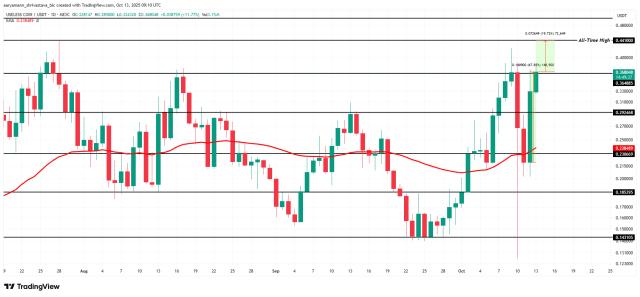Having participated in so many liquidity events over the past few years, I've become numb to the promises of "100%+ APY." Most projects rely on subsidies to stay afloat, only to see their TVL evaporate overnight once the event ends. I was initially skeptical of @MMTFinance's HODL Campaign on Sui. Not only did it attract $30 million in an hour, but funds haven't been withdrawn much since then, and the public offering and points mechanism continue to lock up funds. This demonstrates that it isn't solely relying on airdrop hype, but rather has a sustained incentive structure (ve(3,3) + treasury income). In this era of "retention," Momentum has provided an interesting answer. 1️⃣ Community-first MMT public offering launched @MMTFinance has partnered with @buidlpad to launch the MMT Community Offering, targeting $4.5M. The campaign features two valuation tiers: Tier 1 (lower valuation + higher amount) focuses on early adopters who participate in the HODL/WAGMI campaign; Tier 2 is open to general users who meet applicable regulations. All tokens acquired through this public offering will be 100% unlocked at the TGE, with no lock-up. 2️⃣ Token Scale: Transaction Volume and TVL Soar Since its launch, Momentum has claimed cumulative transaction volume exceeding $16-18 billion and a TVL exceeding $500-550 million. A significant amount of liquidity was "locked up" during the HODL Campaign to qualify for the public offering. This demonstrates that Momentum is transitioning from a "new project runway" to a "mid-scale" development path. 3️⃣ HODL Yield Campaign: Strengthening Liquidity & Community Mobilization As early as the end of September, the HODL campaign jointly launched by Momentum and BeadlePad attracted $30 million in one hour, with the APY capped at 155%. It also incorporated a points mechanism (Bricks). This not only sent a strong signal but also served as a combined "capital reserve pool + community warm-up" strategy. 4️⃣ Model and Mechanism: ve(3,3) + Concentrated Liquidity + Community Equity Momentum's design integrates the ve model and a three-dimensional incentive structure, aiming to integrate the motivations of staking, market making, and community contribution. Its concentrated liquidity design (similar to Uniswap V3) offers a natural advantage within Sui's parallel trading architecture. However, the model itself has its limitations: authoritative governance by large investors, continued pressure after the subsidy reduction, and cross-chain competition encroaching on market share may all pose challenges. 5️⃣ Strategic Path: Developing a Liquidity Hub + Cross-Chain Entry Compared to a pure DEX, Momentum's approach is to combine "treasury/multi-sig/DEX/cross-chain + launchpad" to become the central liquidity platform for the Sui and even Move ecosystems. Through channels like Wormhole and OKX Wallet, it can "bridge" assets from other chains into Sui, making it attractive to external capital. 6️⃣ Three Metrics I'll Focus on What is the TVL drawdown within 72 hours after the public offering? Can the fee income/LP net returns of each pool pair support the post-subsidy ecosystem? What is the composition of assets bridged through cross-chain bridging (stablecoins vs. risk-on coins) and how will liquidity activity be distributed? 7️⃣ Brief Practical Advice for Users Participating in the public offering: If you have points/locked positions in HODL/WAGMI activities, be sure to verify the Tier 1 requirements and quota. Market Making/Liquidity Provision: Prioritize mainstream pairs (such as SUI/USDC and SUI/ETH), focusing on spread and slippage performance. Community Tasks/Points: Allocate your energy wisely, and avoid passively completing ineffective tasks on the "last day" to reach the top of the leaderboard. In short: Momentum is using a combination of a community-driven public offering and a strong liquidity event to sprint toward the critical milestone of "transitioning from subsidy-driven to sustainable development." Its future success will depend on: the retention of funds after the public offering and the ability to realize actual transaction fees in a non-subsidized state.
This article is machine translated
Show original

Sector:
From Twitter
Disclaimer: The content above is only the author's opinion which does not represent any position of Followin, and is not intended as, and shall not be understood or construed as, investment advice from Followin.
Like
Add to Favorites
Comments
Share






